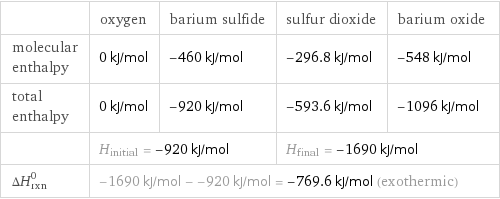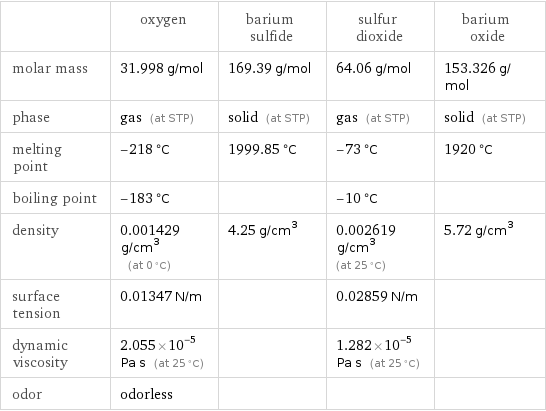Input interpretation

O_2 oxygen + BaS barium sulfide ⟶ SO_2 sulfur dioxide + BaO barium oxide
Balanced equation

Balance the chemical equation algebraically: O_2 + BaS ⟶ SO_2 + BaO Add stoichiometric coefficients, c_i, to the reactants and products: c_1 O_2 + c_2 BaS ⟶ c_3 SO_2 + c_4 BaO Set the number of atoms in the reactants equal to the number of atoms in the products for O, Ba and S: O: | 2 c_1 = 2 c_3 + c_4 Ba: | c_2 = c_4 S: | c_2 = c_3 Since the coefficients are relative quantities and underdetermined, choose a coefficient to set arbitrarily. To keep the coefficients small, the arbitrary value is ordinarily one. For instance, set c_2 = 1 and solve the system of equations for the remaining coefficients: c_1 = 3/2 c_2 = 1 c_3 = 1 c_4 = 1 Multiply by the least common denominator, 2, to eliminate fractional coefficients: c_1 = 3 c_2 = 2 c_3 = 2 c_4 = 2 Substitute the coefficients into the chemical reaction to obtain the balanced equation: Answer: | | 3 O_2 + 2 BaS ⟶ 2 SO_2 + 2 BaO
Structures

+ ⟶ +
Names

oxygen + barium sulfide ⟶ sulfur dioxide + barium oxide
Reaction thermodynamics
Enthalpy

| oxygen | barium sulfide | sulfur dioxide | barium oxide molecular enthalpy | 0 kJ/mol | -460 kJ/mol | -296.8 kJ/mol | -548 kJ/mol total enthalpy | 0 kJ/mol | -920 kJ/mol | -593.6 kJ/mol | -1096 kJ/mol | H_initial = -920 kJ/mol | | H_final = -1690 kJ/mol | ΔH_rxn^0 | -1690 kJ/mol - -920 kJ/mol = -769.6 kJ/mol (exothermic) | | |
Gibbs free energy

| oxygen | barium sulfide | sulfur dioxide | barium oxide molecular free energy | 231.7 kJ/mol | -456 kJ/mol | -300.1 kJ/mol | -520.3 kJ/mol total free energy | 695.1 kJ/mol | -912 kJ/mol | -600.2 kJ/mol | -1041 kJ/mol | G_initial = -216.9 kJ/mol | | G_final = -1641 kJ/mol | ΔG_rxn^0 | -1641 kJ/mol - -216.9 kJ/mol = -1424 kJ/mol (exergonic) | | |
Equilibrium constant
![Construct the equilibrium constant, K, expression for: O_2 + BaS ⟶ SO_2 + BaO Plan: • Balance the chemical equation. • Determine the stoichiometric numbers. • Assemble the activity expression for each chemical species. • Use the activity expressions to build the equilibrium constant expression. Write the balanced chemical equation: 3 O_2 + 2 BaS ⟶ 2 SO_2 + 2 BaO Assign stoichiometric numbers, ν_i, using the stoichiometric coefficients, c_i, from the balanced chemical equation in the following manner: ν_i = -c_i for reactants and ν_i = c_i for products: chemical species | c_i | ν_i O_2 | 3 | -3 BaS | 2 | -2 SO_2 | 2 | 2 BaO | 2 | 2 Assemble the activity expressions accounting for the state of matter and ν_i: chemical species | c_i | ν_i | activity expression O_2 | 3 | -3 | ([O2])^(-3) BaS | 2 | -2 | ([BaS])^(-2) SO_2 | 2 | 2 | ([SO2])^2 BaO | 2 | 2 | ([BaO])^2 The equilibrium constant symbol in the concentration basis is: K_c Mulitply the activity expressions to arrive at the K_c expression: Answer: | | K_c = ([O2])^(-3) ([BaS])^(-2) ([SO2])^2 ([BaO])^2 = (([SO2])^2 ([BaO])^2)/(([O2])^3 ([BaS])^2)](../image_source/42e40831d0a24188f2eb4d0da904376e.png)
Construct the equilibrium constant, K, expression for: O_2 + BaS ⟶ SO_2 + BaO Plan: • Balance the chemical equation. • Determine the stoichiometric numbers. • Assemble the activity expression for each chemical species. • Use the activity expressions to build the equilibrium constant expression. Write the balanced chemical equation: 3 O_2 + 2 BaS ⟶ 2 SO_2 + 2 BaO Assign stoichiometric numbers, ν_i, using the stoichiometric coefficients, c_i, from the balanced chemical equation in the following manner: ν_i = -c_i for reactants and ν_i = c_i for products: chemical species | c_i | ν_i O_2 | 3 | -3 BaS | 2 | -2 SO_2 | 2 | 2 BaO | 2 | 2 Assemble the activity expressions accounting for the state of matter and ν_i: chemical species | c_i | ν_i | activity expression O_2 | 3 | -3 | ([O2])^(-3) BaS | 2 | -2 | ([BaS])^(-2) SO_2 | 2 | 2 | ([SO2])^2 BaO | 2 | 2 | ([BaO])^2 The equilibrium constant symbol in the concentration basis is: K_c Mulitply the activity expressions to arrive at the K_c expression: Answer: | | K_c = ([O2])^(-3) ([BaS])^(-2) ([SO2])^2 ([BaO])^2 = (([SO2])^2 ([BaO])^2)/(([O2])^3 ([BaS])^2)
Rate of reaction
![Construct the rate of reaction expression for: O_2 + BaS ⟶ SO_2 + BaO Plan: • Balance the chemical equation. • Determine the stoichiometric numbers. • Assemble the rate term for each chemical species. • Write the rate of reaction expression. Write the balanced chemical equation: 3 O_2 + 2 BaS ⟶ 2 SO_2 + 2 BaO Assign stoichiometric numbers, ν_i, using the stoichiometric coefficients, c_i, from the balanced chemical equation in the following manner: ν_i = -c_i for reactants and ν_i = c_i for products: chemical species | c_i | ν_i O_2 | 3 | -3 BaS | 2 | -2 SO_2 | 2 | 2 BaO | 2 | 2 The rate term for each chemical species, B_i, is 1/ν_i(Δ[B_i])/(Δt) where [B_i] is the amount concentration and t is time: chemical species | c_i | ν_i | rate term O_2 | 3 | -3 | -1/3 (Δ[O2])/(Δt) BaS | 2 | -2 | -1/2 (Δ[BaS])/(Δt) SO_2 | 2 | 2 | 1/2 (Δ[SO2])/(Δt) BaO | 2 | 2 | 1/2 (Δ[BaO])/(Δt) (for infinitesimal rate of change, replace Δ with d) Set the rate terms equal to each other to arrive at the rate expression: Answer: | | rate = -1/3 (Δ[O2])/(Δt) = -1/2 (Δ[BaS])/(Δt) = 1/2 (Δ[SO2])/(Δt) = 1/2 (Δ[BaO])/(Δt) (assuming constant volume and no accumulation of intermediates or side products)](../image_source/c5431f547cd689d34a10510467d37b9c.png)
Construct the rate of reaction expression for: O_2 + BaS ⟶ SO_2 + BaO Plan: • Balance the chemical equation. • Determine the stoichiometric numbers. • Assemble the rate term for each chemical species. • Write the rate of reaction expression. Write the balanced chemical equation: 3 O_2 + 2 BaS ⟶ 2 SO_2 + 2 BaO Assign stoichiometric numbers, ν_i, using the stoichiometric coefficients, c_i, from the balanced chemical equation in the following manner: ν_i = -c_i for reactants and ν_i = c_i for products: chemical species | c_i | ν_i O_2 | 3 | -3 BaS | 2 | -2 SO_2 | 2 | 2 BaO | 2 | 2 The rate term for each chemical species, B_i, is 1/ν_i(Δ[B_i])/(Δt) where [B_i] is the amount concentration and t is time: chemical species | c_i | ν_i | rate term O_2 | 3 | -3 | -1/3 (Δ[O2])/(Δt) BaS | 2 | -2 | -1/2 (Δ[BaS])/(Δt) SO_2 | 2 | 2 | 1/2 (Δ[SO2])/(Δt) BaO | 2 | 2 | 1/2 (Δ[BaO])/(Δt) (for infinitesimal rate of change, replace Δ with d) Set the rate terms equal to each other to arrive at the rate expression: Answer: | | rate = -1/3 (Δ[O2])/(Δt) = -1/2 (Δ[BaS])/(Δt) = 1/2 (Δ[SO2])/(Δt) = 1/2 (Δ[BaO])/(Δt) (assuming constant volume and no accumulation of intermediates or side products)
Chemical names and formulas

| oxygen | barium sulfide | sulfur dioxide | barium oxide formula | O_2 | BaS | SO_2 | BaO Hill formula | O_2 | BaS | O_2S | BaO name | oxygen | barium sulfide | sulfur dioxide | barium oxide IUPAC name | molecular oxygen | thioxobarium | sulfur dioxide | oxobarium
Substance properties

| oxygen | barium sulfide | sulfur dioxide | barium oxide molar mass | 31.998 g/mol | 169.39 g/mol | 64.06 g/mol | 153.326 g/mol phase | gas (at STP) | solid (at STP) | gas (at STP) | solid (at STP) melting point | -218 °C | 1999.85 °C | -73 °C | 1920 °C boiling point | -183 °C | | -10 °C | density | 0.001429 g/cm^3 (at 0 °C) | 4.25 g/cm^3 | 0.002619 g/cm^3 (at 25 °C) | 5.72 g/cm^3 surface tension | 0.01347 N/m | | 0.02859 N/m | dynamic viscosity | 2.055×10^-5 Pa s (at 25 °C) | | 1.282×10^-5 Pa s (at 25 °C) | odor | odorless | | |
Units
